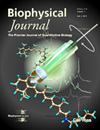Revealing the glutamate switch: insights into proton translocation in plant H+-pyrophosphatase.
IF 3.1
3区 生物学
Q2 BIOPHYSICS
引用次数: 0
Abstract
Membrane-bound pyrophosphatases (M-PPases) are responsible for the hydrolysis of pyrophosphate (PPi), coupled with the pumping of H+ and/or Na+ across the membrane. In Vigna radiata H+-translocating pyrophosphatase (VrH+-PPase), proton translocation involves both a "binding change" mechanism, where PPi binding induces proton translocation, and the "Grotthuss-chain" mechanism, which describes proton translocation along the ion gate, hydrophobic gate, and exit channel. However, the dynamic coupling between protonation states and conformational changes in VrH+-PPase remains unclear, partly due to the challenges of experimentally capturing transient states during transport. To address this, we employed constant pH molecular dynamics (CpHMD) and classical molecular dynamics (MD) simulations to elucidate the proton transport mechanism from the ion gate (R242/D294/K742/E301) to the hydrophobic gate (L232/A305/L555/V746). Our simulations reveal that K742 becomes deprotonated upon PPi binding, suggesting its potential role as an internal proton donor. When K742 is deprotonated, E301 penetrates the hydrophobic gate and creates a hydrophilic environment for proton transport. Following PPi hydrolysis, D294 accepts a hydrolysis-generated proton to become protonated, inducing R242 to act as a positive plug that prevents the re-protonation of D294. Meanwhile, the protonation of D294 causes E301 to rebound and close the hydrophobic gate. We propose that E301 acts as a molecular switch, regulating proton transport through the hydrophobic gate. Furthermore, we suggest the penetration of glutamate is a conserved feature among plant H+-PPases, maintaining a consistent hydrophilic environment at the hydrophobic gate in H+-PPases. In conclusion, proton translocation in plant H+-PPases involves lysine deprotonation in the PPi-bound state and aspartate protonation in the PPi-hydrolyzed states, with glutamate switch dynamically regulating the opening and closing of the hydrophobic gate.揭示谷氨酸开关:对植物H+-焦磷酸酶质子易位的见解。
膜结合焦磷酸酶(M-PPases)负责焦磷酸盐(PPi)的水解,并通过膜泵送H+和/或Na+。在Vigna radiata H+-易位焦磷酸酶(VrH+-PPase)中,质子易位既包括“结合改变”机制(PPi结合诱导质子易位),也包括“Grotthuss-chain”机制(质子沿离子门、疏水门和出口通道易位)。然而,VrH+-PPase质子化态和构象变化之间的动态耦合仍然不清楚,部分原因是由于在实验中捕捉传输过程中的瞬态存在挑战。为了解决这个问题,我们采用恒定pH分子动力学(CpHMD)和经典分子动力学(MD)模拟来阐明质子从离子门(R242/D294/K742/E301)到疏水门(L232/A305/L555/V746)的输运机制。我们的模拟表明,K742在PPi结合后会去质子化,这表明它可能是一个内部质子供体。当K742去质子化时,E301穿过疏水门,为质子运输创造亲水性环境。PPi水解后,D294接受水解产生的质子成为质子化,诱导R242作为正极堵塞阻止D294的再质子化。同时,D294的质子化使E301反弹,关闭疏水门。我们提出E301作为一个分子开关,调节质子通过疏水门的传输。此外,我们认为谷氨酸的渗透是植物H+-PPases的一个保守特征,在H+-PPases的疏水门处保持一致的亲水环境。综上所述,植物H+-PPases的质子易位涉及到ppi结合状态下的赖氨酸去质子化和ppi水解状态下的天冬氨酸质子化,谷氨酸开关动态调节疏水门的开启和关闭。
本文章由计算机程序翻译,如有差异,请以英文原文为准。
求助全文
约1分钟内获得全文
求助全文
来源期刊

Biophysical journal
生物-生物物理
CiteScore
6.10
自引率
5.90%
发文量
3090
审稿时长
2 months
期刊介绍:
BJ publishes original articles, letters, and perspectives on important problems in modern biophysics. The papers should be written so as to be of interest to a broad community of biophysicists. BJ welcomes experimental studies that employ quantitative physical approaches for the study of biological systems, including or spanning scales from molecule to whole organism. Experimental studies of a purely descriptive or phenomenological nature, with no theoretical or mechanistic underpinning, are not appropriate for publication in BJ. Theoretical studies should offer new insights into the understanding ofexperimental results or suggest new experimentally testable hypotheses. Articles reporting significant methodological or technological advances, which have potential to open new areas of biophysical investigation, are also suitable for publication in BJ. Papers describing improvements in accuracy or speed of existing methods or extra detail within methods described previously are not suitable for BJ.
 求助内容:
求助内容: 应助结果提醒方式:
应助结果提醒方式:


